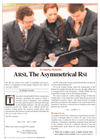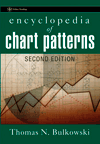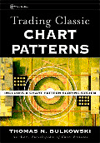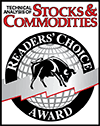December 2008 Letters To The Editor
The editors of S&C invite readers to submit their opinions and information on subjects relating to technical analysis and this magazine. This column is our means of communication with our readers. Is there something you would like to know more (or less) about? Tell us about it. Without a source of new ideas and subjects coming from our readers, this magazine would not exist.
Address your correspondence to: Editor, Stocks & Commodities, 4757 California Ave. SW, Seattle, WA 98116-4499, or E-mail to editor@traders.com. All letters become the property of Technical Analysis, Inc. Letter-writers must include their full name and address for verification. Letters may be edited for length or clarity. The opinions expressed in this column do not necessarily represent those of the magazine. —Editor
Mac Software Revisited
 Editor,
Editor,
In your September 2008 Letters To S&C column, letter-writer John Hammerstrom inquired about programs available for Apple Macintosh computers.
I am writing to let readers know about a software program called Parallels Desktop for Mac, which sells for less than $100. This program creates a “parallel environment” within the Mac that runs any Windows-based program. I use Parallels nightly to run my Worden and Advanced Get programs; it’s wonderful.
—Merrill S. Lichtenfeld
Thank you for writing in with your suggestion.—Editor
Asymmetrical Rsi
 Editor,
Editor,
It seems to me that Sylvain Vervoort is barking up the wrong tree with his asymmetrical Rsi concept (“Arsi, The Asymmetrical Rsi,” October 2008 Stocks & Commodities).
To support his claim that the Arsi is more responsive than the standard Rsi, he graphically compared the two Rsis on one chart. But he is comparing apples to oranges. If you compute an Rsi with a period of 27 (2*Wilder period of 14–1), and an Arsi with the same period, you don’t get results that can be compared, because the effective period of the Arsi is not 27, but half that. This is because the period of 27 bars is being split between the up average and the down average. The relative periods of these two computations vary around the midpoint, which would be 13.5, and the resulting Arsi computation ends up being very close to a standard Rsi with a period of 13.5 (an Ema can handle non-integer periods). All he is saying then, without realizing it, is that a 13.5-period Rsi is more responsive than a 27-period Rsi. But we already know that.
—John Leonatti
Sylvain Vervoort replies:
It is correct that the Arsi is basically using a shorter-term average by splitting the period in two parts: an up and a down part. It is also correct that you will see little difference most of the time between Arsi and just using half the period for the averaging. Nevertheless, if you look at more charts in detail, you will notice there are more reliable divergences with Arsi than with a half-period approach. And that is the main idea behind the Arsi: to get as many short-term reliable divergences as possible. In the Traders’ Tips section of the October 2008 issue, Richard Denning — writing code for both Aiq and TradersStudio — published the results of trading divergences based on the standard Rsi and the Arsi. In the TradersStudio test, the results showed that for trading long positions, the Arsi was about six times more profitable. So I would say that the idea of looking for more divergences is not a bad idea.
It is possible that running the same test with a fixed shorter-term average will show little difference. But you have to think about the idea behind the Arsi. Applying the Arsi shows that the up and down days averaging does indeed have some influence in the market. After all, I believe we are all trying to make as much of a profit as possible with our trading. And yes, I realize that the shorter the averaging period, the more responsive the indicator, but as stated before, I was looking for more reliable divergences, and I found them with Arsi. So, I hope that this idea is still useful for you.
Etf Pattern Screening
 Editor,
Editor,
I am trying to find a software company that will screen Etfs for patterns (such as double tops and bottoms). Do you have any suggestions?
—John Ryan
There is software available that can screen charts for patterns. We recently reviewed PatternMatcher by TD Ameritrade, and in the past, we have reviewed products such as MetaStock plug-ins, TradeStation, and various other programs that recognize patterns. You could always try to create custom programs that help to identify patterns; however, it’s not an easy task since finding patterns is more art than science and involves a lot of subjectivity.—Editor
The Most Profitable Chart Patterns?
Editor,
I’m wondering if you know of any articles or books that contain results on backtesting chart patterns. Out of the following list of chart patterns, which is the most profitable or has the highest chance of hitting the target?
- Rectangular breakout
- Alligator
- Head & shoulders
- Inverse head & shoulders
- Triple tops
- Triple bottoms
- Double tops
- Double bottoms
—William Cheng, Singapore
I would direct you to a couple of books by Thomas Bulkowski:

 1. The Encyclopedia Of Chart Patterns
1. The Encyclopedia Of Chart Patterns2. Trading Classic Chart Patterns
In these, I think you’ll find everything you want to know about the patterns you mentioned, including which are the most profitable and which have the highest chance of hitting their target. —Editor
Product Reviews
Editor,
Sometime in 2007, S&C editor Jayanthi Gopalakrishnan reviewed MultiCharts. Has anyone there done a side-by-side comparison of MultiCharts vs. QCharts, and if so, which one won?
—David Carpenter
We do not publish editorial comparisons of products side-by-side; our preferred format is to publish standalone reviews on individual products. Our goal is to write about how the software feels to use and whether it would be helpful to traders in their trading. Comparisons can be unfair because the intent of products can be different, as can their features and their price.
However, we offer our Readers’ Choice Awards in our annual Bonus Issue, in which we present a list of products in different categories and rank them in order of reader votes for the products. Voting is under way now for the Readers’ Choice Awards to be presented in our 2009 Bonus Issue, which will mail to subscribers in February. Subscribers who wish to vote in the current poll can visit our website at Traders.com, and click on the “Vote now” button on our home page. Voting ends December 31.—Editor
Readers’ Choice Awards
 Editor,
Editor,
I am writing to find out more about the Readers’ Choice Award promotion you featured in your November 2008 issue of Stocks & Commodities. I am interested in finding out how to vote (that is, where we go to place our vote) and how one’s company is recognized or has the opportunity to receive this award. Any insight you may have would be much appreciated.
—Jaclyn Cole
Every year, we ask our readers to vote online at our website, Traders.com, for the products and services they have found most useful for their trading in the past year. We compile the results in our Readers’ Choice Awards (Rca) and present them in our annual Bonus Issue, which is mailed to subscribers and also sold for a limited time on the newsstands. Voting is limited to S&C subscribers and product vendors, and is open for a period at the end of the year.—Editor
Charting Software
Editor,
I would like to know if you can assist me in the following.
I used to use TradeStation software while working for my previous employer. I like the fact that this software is rule-based, so I could enter my risk parameters and so on, and charts could get modeled. I’m not an expert in this field, as some of your readers are. I do know that many software packages require a datafeed that comes at a cost. My question is: Is there a package out there that uses rule-based parameters but also can have prices updated through a [free] website such as Msn or Yahoo! Finance, without having to subscribe to a datafeed? I don’t mind if the software allows the option to use a subscription-based datafeed that I might choose to use in the future, but at the moment I would just like to purchase a piece of software and not need to spend anything extra on it.
If you know where I can go for this, please point me in the right direction.
—Lance Engelbrecht
Wealth-Lab is rule-based charting software that you can use a free data source with. However, Wealth-Lab partners with Fidelity Investments, and in this country and Canada, the program is only available to Fidelity account holders. We don’t know of any other products that fit your description.—Editor
Software For Indian Stock Market?
 Editor,
Editor,
I am writing from Chennai, India. Last month, I came across your magazine. It’s a great magazine and it’s really amazing for me to find such a good periodical for traders that is not based in India. It is a pool of thoughts and technicals for traders. I really appreciate you and your team for the hard work and research behind this magazine.
I have gone through your online store and products in detail, but I can’t find software for use on the Indian market. I would like to know which software would be best.
—Sai Saravana
Thank you for writing. There is software available specifically for the Indian stock market. I would recommend that you do an Internet search for the terms “Indian stock market” and “software,” and you’ll see that you have several choices. —Editor